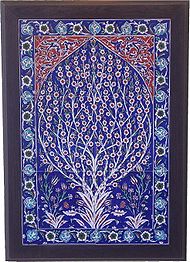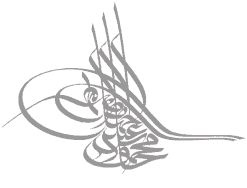
Turkish art
Encyclopedia

Turkey
Turkey , known officially as the Republic of Turkey , is a Eurasian country located in Western Asia and in East Thrace in Southeastern Europe...
since the arrival of the Turks in the Middle Ages. Turkey also was the home of much significant art produced by earlier cultures, including the Hittites
Hittites
The Hittites were a Bronze Age people of Anatolia.They established a kingdom centered at Hattusa in north-central Anatolia c. the 18th century BC. The Hittite empire reached its height c...
, Ancient Greeks, and Byzantines
Byzantine art
Byzantine art is the term commonly used to describe the artistic products of the Byzantine Empire from about the 5th century until the Fall of Constantinople in 1453....
. The 16th and 17th centuries are generally recognised as the finest period for art in the Ottoman Empire
Ottoman Empire
The Ottoman EmpireIt was usually referred to as the "Ottoman Empire", the "Turkish Empire", the "Ottoman Caliphate" or more commonly "Turkey" by its contemporaries...
, much of it associated with the huge Imperial court. Apart from Ottoman architecture and Ottoman illumination
Ottoman illumination
Turkish or Ottoman illumination covers non-figurative painted or drawn decorative art in books or on sheets in muraqqa or albums, as opposed to the figurative images of the Ottoman miniature. In Turkish it is called “tezhip”, an Arabic word which means “ornamenting with gold”...
of manuscripts the most important media were in the applied or decorative arts rather than figurative work. Pottery, especially İznik pottery
Iznik pottery
İznik pottery, named after the town in western Anatolia where it was made, is highly decorated ceramics that was produced between the late 15th and 17th centuries....
, hardstone carving
Hardstone carving
Hardstone carving is a general term in art history and archaeology for the carving for artistic purposes of semi-precious stones, also known as gemstones, such as jade, rock crystal , agate, onyx, jasper, serpentine or carnelian, and for an object made in this way. Normally the objects are small,...
s, Turkish carpet
Turkish carpet
Turkish carpets come in distinct styles, from different regions of Turkey. Important differentiators between the types include the materials, construction and the patterns.-History:...
s and textiles were all produced to extremely high standards. Other Turkish art ranges from traditional Ebru or paper marbling
Paper marbling
Paper marbling is a method of aqueous surface design, which can produce patterns similar to smooth marble or other stone. The patterns are the result of color floated on either plain water or a viscous solution known as size, and then carefully transferred to an absorbent surface, such as paper or...
to Western style paintings.
A transition from Islamic artistic traditions under the Ottoman Empire
Ottoman Empire
The Ottoman EmpireIt was usually referred to as the "Ottoman Empire", the "Turkish Empire", the "Ottoman Caliphate" or more commonly "Turkey" by its contemporaries...
to a more secular, Western orientation has taken place in Turkey
Turkey
Turkey , known officially as the Republic of Turkey , is a Eurasian country located in Western Asia and in East Thrace in Southeastern Europe...
. Turkish painters today are striving to find their own art forms, free from Western influence. Sculpture is less developed, and public monuments are usually heroic representations of Atatürk and events from the war of independence. Literature is considered the most advanced of contemporary Turkish arts.
The reign of the early Ottoman
Ottoman Empire
The Ottoman EmpireIt was usually referred to as the "Ottoman Empire", the "Turkish Empire", the "Ottoman Caliphate" or more commonly "Turkey" by its contemporaries...
Turks
Turkey
Turkey , known officially as the Republic of Turkey , is a Eurasian country located in Western Asia and in East Thrace in Southeastern Europe...
in the 16th and early 17th centuries introduced the Turkish form of Islamic calligraphy
Islamic calligraphy
Islamic calligraphy, colloquially known as Perso-Arabic calligraphy, is the artistic practice of handwriting, or calligraphy, and by extension, of bookmaking, in the lands sharing a common Islamic cultural heritage. This art form is based on the Arabic script, which for a long time was used by all...
. This art form reached the height of its popularity during the reign of Suleiman the Magnificent
Suleiman the Magnificent
Suleiman I was the tenth and longest-reigning Sultan of the Ottoman Empire, from 1520 to his death in 1566. He is known in the West as Suleiman the Magnificent and in the East, as "The Lawgiver" , for his complete reconstruction of the Ottoman legal system...
(1520–66). As decorative as it was communicative, Diwani
Diwani
Diwani is a calligraphic variety of Arabic script, a cursive style developed during the reign of the early Ottoman Turks...
was distinguished by the complexity of the line within the letter and the close juxtaposition of the letters within the word.

See also
- Ottoman miniatureOttoman miniatureOttoman Miniature or Turkish miniature was an art form in the Ottoman Empire, which can be linked to the Persian miniature tradition, as well as strong Chinese artistic influences. It was a part of the Ottoman Book Arts together with illumination , calligraphy , marbling paper and bookbinding...
- Culture of the Ottoman EmpireCulture of the Ottoman EmpireThe culture of the Ottoman Empire evolved over several centuries as the ruling administration of the Turks absorbed, adapted and modified the cultures of conquered lands and their peoples...

